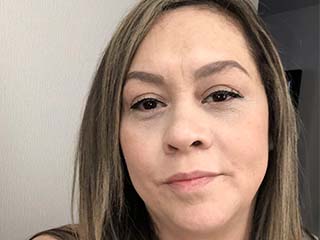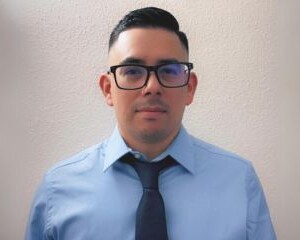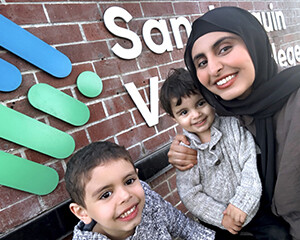Clinical Medical Assisting program faculty member puts students in line for long-term success
 Corinna Avina never had that common childhood dream of one day becoming a teacher. Instead she chose a path and supporting education that prepared her to work as a Medical Assistant (MA) where over an 18-year period she moved from Medical Assistant to MA Supervisor to Floor Supervisor responsible for 20-30 employees at various sites through Adventist Health. Life was good.
Corinna Avina never had that common childhood dream of one day becoming a teacher. Instead she chose a path and supporting education that prepared her to work as a Medical Assistant (MA) where over an 18-year period she moved from Medical Assistant to MA Supervisor to Floor Supervisor responsible for 20-30 employees at various sites through Adventist Health. Life was good.
But destiny was about to intervene. “The Dean on the Hanford (SJVC) campus reached out to me and asked if I would like to teach,” Corinna remembers. “I told her I’d never thought about teaching. She said, ‘You do it every day when you teach new Medical Assistants coming in.’ “I thought about it and sent in my application and resume.”
The wheels moved quickly. “The next thing you know I went in for an interview, then demo teach-out,” she remembers. The Hanford campus snapped her up for their evening classes. Corinna continued to work full-time at the hospital while starting her part-time teaching position. But that system did not last long.
Three months was all it took. “Once I got going, I realized I loved teaching, so I let my other job go,” she remembers. “I knew this is it.” And soon after, when a full-time position opened, she grabbed it.
“I love my job and enjoy coming to work every day, interacting with the students, watching them grow, excited and eager to learn new things,” she says.
Corinna gets all the way in. “I’m more of the nurturing type of instructor. I’m the one that, if they need help after-hours, I’m open.” That there-for-you attitude has been especially important for CMA students since programs transferred to distance learning these last few months of CoVid precautions. “I have what I call ‘open hours’ for anyone who needed special attention.”
Now that Clinical Medical Assisting program students have returned to campus three days a week a faculty member’s attention is even more readily available. “Tuesdays, Wednesdays and Thursdays we are in lab practicing our skills,” says Corinna. “Students are so happy to be back on campus and practicing what they’ve been studying on their distance learning.”
It is not all rubber gloves, masks and protective gear students are incorporating into their medical procedures’ skill-building. Corinna emphasizes the importance of what she calls the ‘soft skills’ that the most proficient Medical Assistants master. “There is a need for work-place professionalism toward both patients and colleagues,” Corinna explains. “It’s politeness, mannerisms and good communication skills that pack more power than you might imagine. It’s hard for students to realize the impact of those ‘soft skills’ until they’re actually there and feel the response.”
Her CMA students receive in-depth study and experience in the more common areas of responsibility. “They are fully trained in all aspects of front and back office operation,” says Corinna. “That includes the back office technical skills of injections, venipuncture, taking vital signs, as well as front office responsibilities such as telephone skills, insurance payments and patient appointments. Attitude and attendance fall into the area of professionalism, too.”
Her students have many reasons for enrolling in SJVC’s Clinical Medical Assisting program. “Medical Assisting can be a stepping-stone for students who want to get into a Registered Nurse or Physician Assistant program. Their attitude is Let me reach for the stars – nothing is impossible, and they keep going to see what they can achieve.”
Sometimes their motivation is deeper and has an impact beyond a secure career. “Many come to us as the first generation in their family to go to college and there’s definitely a lot of them setting an example for other family members and peers,” says Corinna. “They are really just giving their all to the program because of that example to brothers, sisters, children and friends to hopefully follow.”
That educational stretch can call on muscles not previously exercised. “A few students start the program a little rough around the edges,” says Corinna. “They start slow but gain momentum as their hard work and momentum begin to show. So often those beginning underachievers come out on top and by the end of the program are on the Dean’s List (for academic achievement).”
Those early rough edges have a way of smoothing out over time. “They’re constantly polishing themselves and don’t even realize it.” says Corinna.
When students struggle, they often find greater strength in each other. “They work together as a team and don’t want to let each other down,” Corinna describes the dynamic. “Teamwork starts in the classroom, and it is my hope that they take it into the workplace and become that same awesome team member at the place they’re going to work.”
Corinna brings a lot of what her students need from her own strengths and experiences. “Leadership always came naturally to me and I just ran with it. I lead my classroom that way, and I try to instill those skills in my students. They must be leaders, not followers. I tell them, ‘You have to jump in when you see a need and not wait to be asked’. That’s what makes a good Medical Assistant.”
Corinna gets a lot of that wisdom from her own experiences growing up – and one especially important influence. Her mom, Linda. “She’s always been there and inspired me to be better,” Corinna remembers. “She’ the person in my life who’s been the most positive and enriching – she’s still there to this day doing that.”
Many students do not have that person of encouragement and influence close by. “I like to let myself be that positive person for those students who don’t have that role model in life to push them to be better. I’ve seen it time and time again. The expectation is for them to go to work – not college. I remind them that an education is going to give them a career, instead of a field.”
When it comes to her students, Corinna is all in. “Whatever it takes, I’m there for them. One-on-one tutoring weekends or late at night after they get off work. They know I will work with them 100%.”
That kind of support creates a durable bond during hardship, but a feeling of loss when goals are achieved. “The hardest part of my job is, you get attached to some of these students and in the end, they go off to their careers. It’s sad but also a happy time. It’s like my children going off but gratifying for me to watch them become great in their new profession.”
She likes to think of this process like nature’s evolution. “I look at them as caterpillars that bloom into beautiful butterflies. They start small then flourish into something big and beautiful. That process, that’s the ‘wow’ moment for me.”
The flutter of all those wings create a vibration felt by many for years to come.
Learn More About A Career In Medical Assisting
Whether you have always wanted to work in the medical field or you’re realizing a new passion for medicine, continue reading to learn more about what a medical assistant does, how to become one, how to choose a Medical Assisting program and California’s state-specific requirements for certification.
You might also like
More stories about
Request Information
All fields using an asterik (*) are required.


